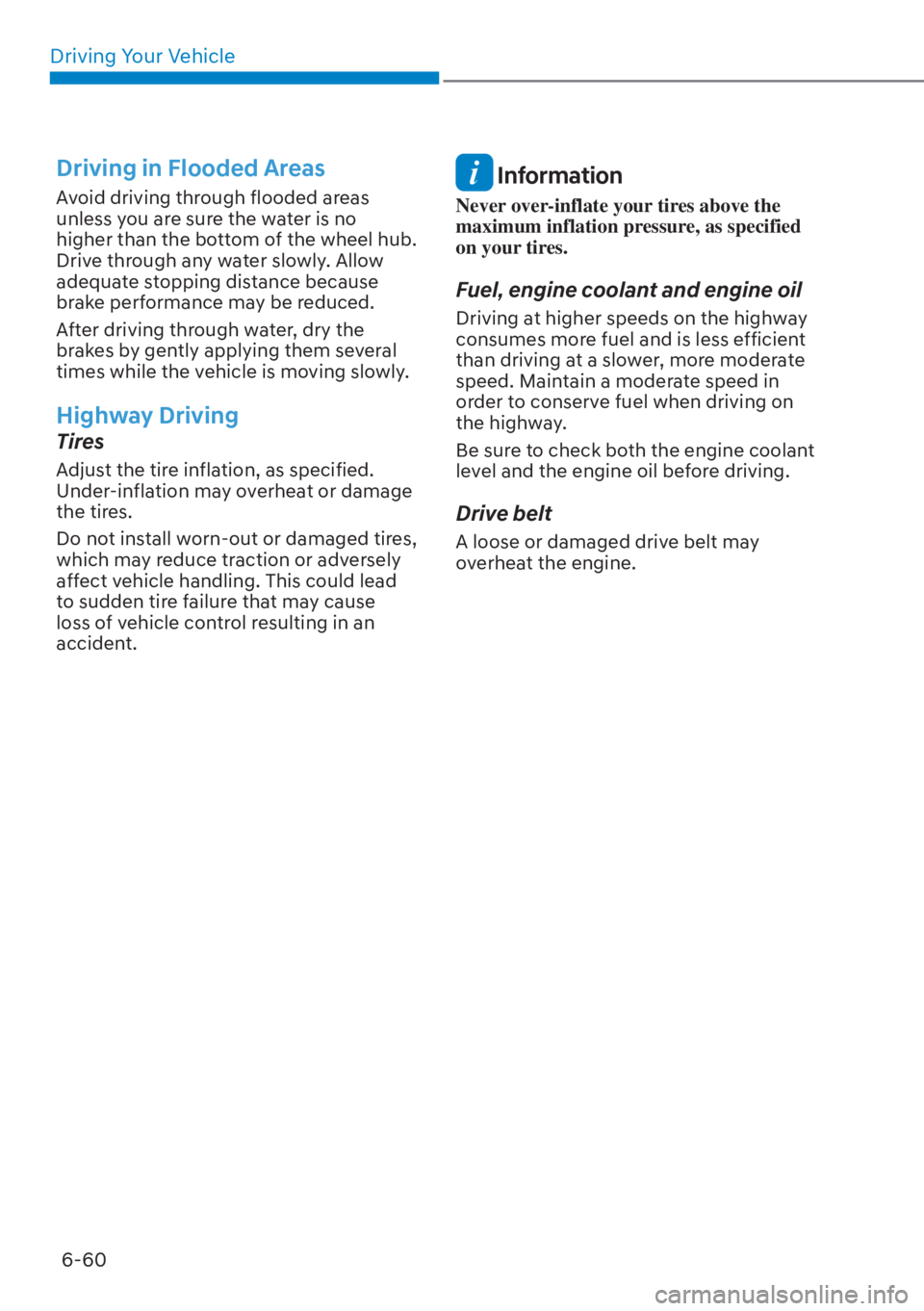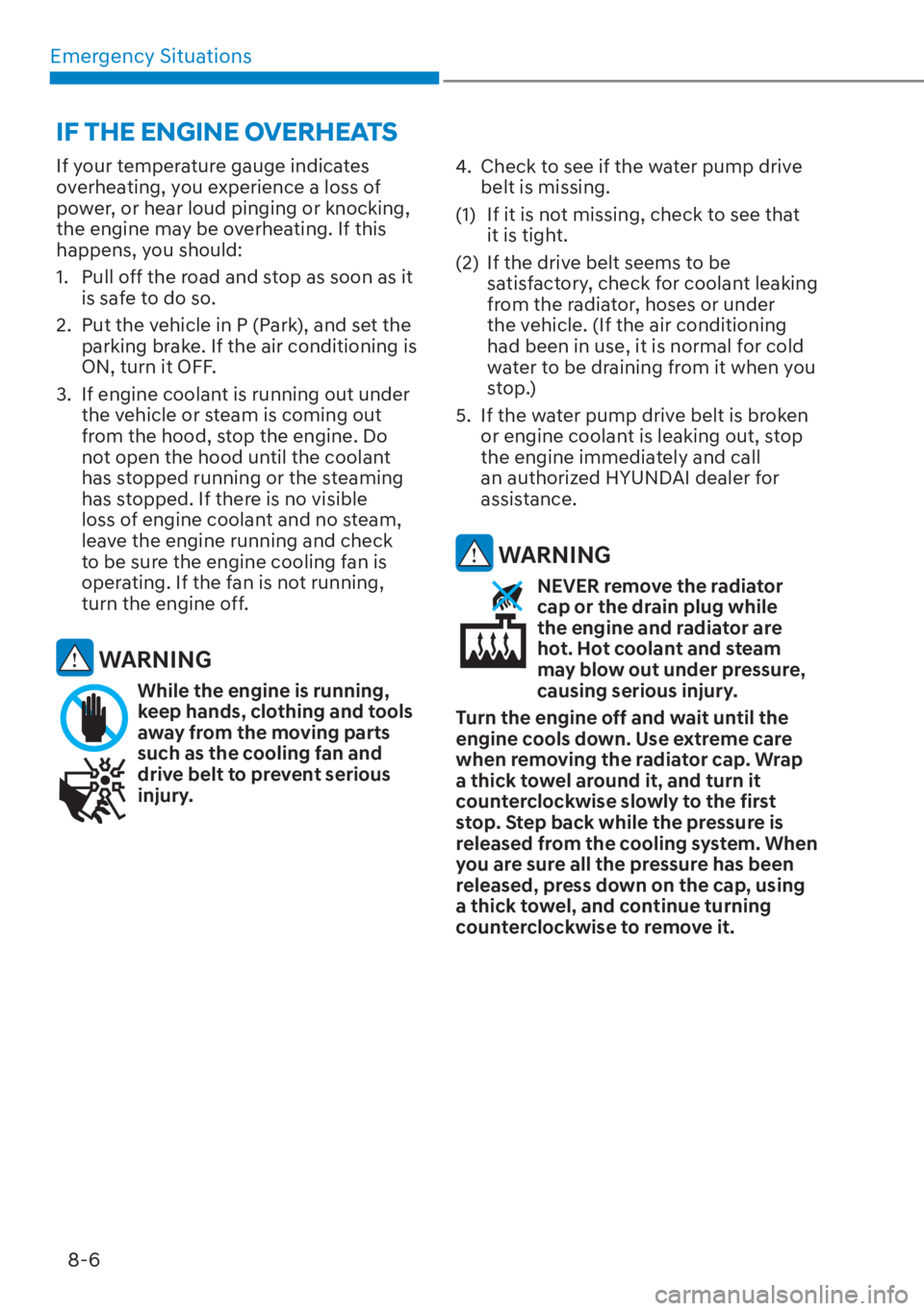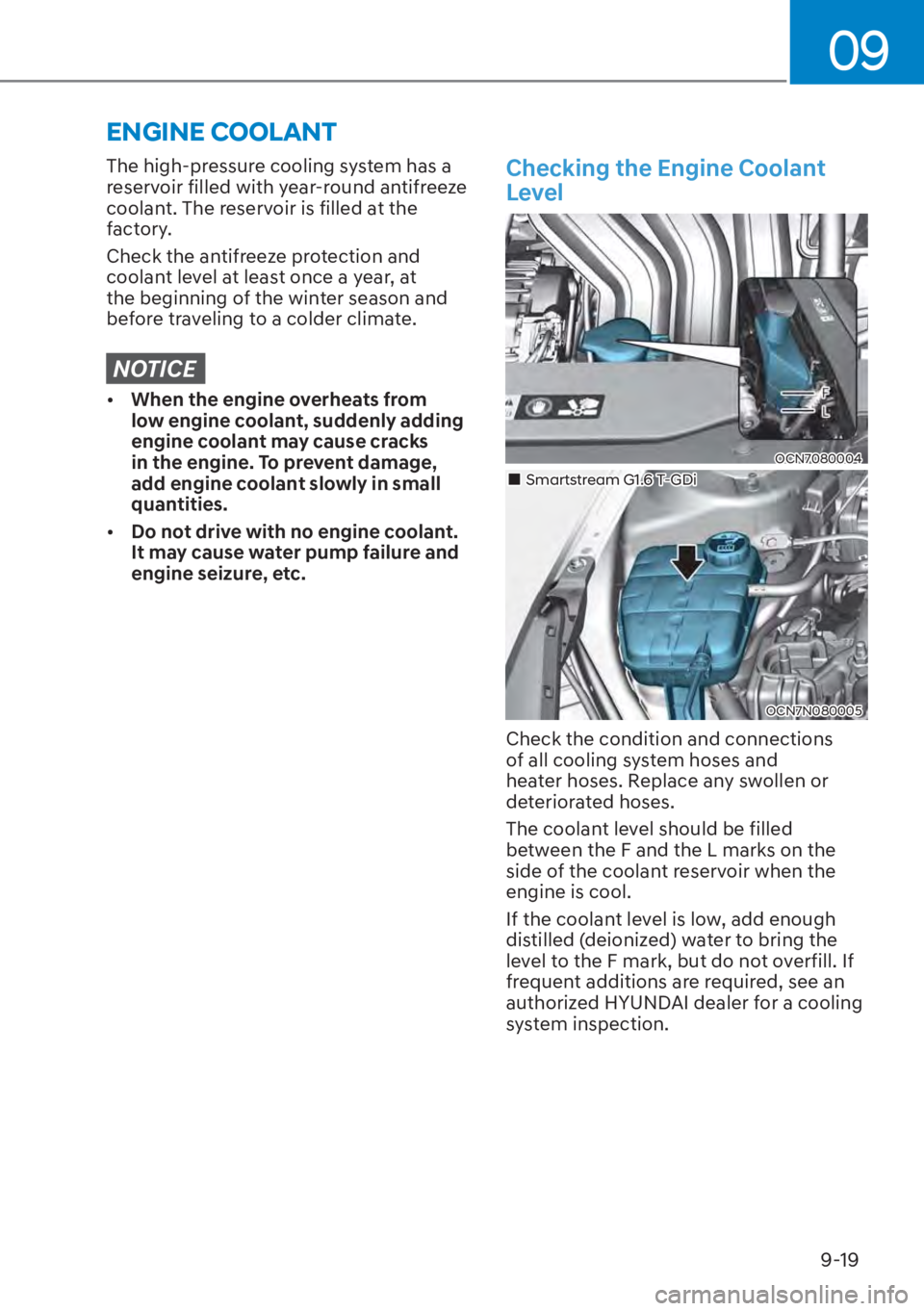Page 318 of 572

Driving Your Vehicle6-60
Driving in Flooded Areas
Avoid driving through flooded areas
unless you are sure the water is no
higher than the bottom of the wheel hub.
Drive through any water slowly. Allow
adequate stopping distance because
brake performance may be reduced.
After driving through water, dry the
brakes by gently applying them several
times while the vehicle is moving slowly.
Highway Driving
Tires
Adjust the tire inflation, as specified.
Under-inflation may overheat or damage
the tires.
Do not install worn-out or damaged tires,
which may reduce traction or adversely
affect vehicle handling. This could lead
to sudden tire failure that may cause
loss of vehicle control resulting in an
accident.
Information
Never over-inflate your tires above the
maximum inflation pressure, as specified
on your tires.
Fuel, engine coolant and engine oil
Driving at higher speeds on the highway
consumes more fuel and is less efficient
than driving at a slower, more moderate
speed. Maintain a moderate speed in
order to conserve fuel when driving on
the highway.
Be sure to check both the engine coolant
level and the engine oil before driving.
Drive belt
A loose or damaged drive belt may
overheat the engine.
Page 474 of 572

Hazard Warning Flasher ........................................................................\
........ 8-2
In Case of an Emergency While Driving ....................................................... 8-2
If the Engine Stalls While Driving ........................................................................\
.... 8-2
If the Engine Stalls at a Crossroad or Crossing ...................................................... 8-2
If you Have a Flat Tire While Driving ....................................................................... 8-3
If the Engine Will not Start ........................................................................\
.... 8-3If the Engine Doesn’t Turn Over or Turns Over Slowly ........................................... 8-3
If the Engine Turns Over Normally but Doesn’t Start ............................................. 8-3
Jump Starting ........................................................................\
........................8-4
If the engine overheats ........................................................................\
..........8-6
Tire Pressure Monitoring System (TPMS) ....................................................8-8
Check Tire Pressure ........................................................................\
..........................8-8
Tire Pressure Monitoring System ........................................................................\
.... 8-9
Low Tire Pressure Telltale ........................................................................\
.............. 8-10
Low Tire Pressure Position and Tire Pressure Telltale .......................................... 8-10
TPMS (Tire Pressure Monitoring System) Malfunction Indicator ......................... 8-12
Changing a Tire with TPMS ........................................................................\
............ 8-12
If you Have a Flat Tire (With spare tire) ...................................................... 8-14Jack and Tools ........................................................................\
.................................8-14
Changing Tires ........................................................................\
.................................8-15
Towing ...................................................................\
.......................................8-20Towing Service ........................................................................\
............................... 8-20
Removable Towing Hook ........................................................................\
................ 8-21
Emergency Towing ........................................................................\
......................... 8-22
8. Emergency Situations
8
Page 479 of 572

Emergency Situations8-6
If your temperature gauge indicates
overheating, you experience a loss of
power, or hear loud pinging or knocking,
the engine may be overheating. If this
happens, you should:
1. Pull off the road and stop as soon as it is safe to do so.
2. Put the vehicle in P (Park), and set the parking brake. If the air conditioning is
ON, turn it OFF.
3. If engine coolant is running out under the vehicle or steam is coming out
from the hood, stop the engine. Do
not open the hood until the coolant
has stopped running or the steaming
has stopped. If there is no visible
loss of engine coolant and no steam,
leave the engine running and check
to be sure the engine cooling fan is
operating. If the fan is not running,
turn the engine off.
WARNING
While the engine is running,
keep hands, clothing and tools
away from the moving parts
such as the cooling fan and
drive belt to prevent serious
injury. 4. Check to see if the water pump drive
belt is missing.
(1) If it is not missing, check to see that it is tight.
(2) If the drive belt seems to be satisfactory, check for coolant leaking
from the radiator, hoses or under
the vehicle. (If the air conditioning
had been in use, it is normal for cold
water to be draining from it when you
stop.)
5. If the water pump drive belt is broken or engine coolant is leaking out, stop
the engine immediately and call
an authorized HYUNDAI dealer for
assistance.
WARNING
NEVER remove the radiator
cap or the drain plug while
the engine and radiator are
hot. Hot coolant and steam
may blow out under pressure,
causing serious injury.
Turn the engine off and wait until the
engine cools down. Use extreme care
when removing the radiator cap. Wrap
a thick towel around it, and turn it
counterclockwise slowly to the first
stop. Step back while the pressure is
released from the cooling system. When
you are sure all the pressure has been
released, press down on the cap, using
a thick towel, and continue turning
counterclockwise to remove it.
IF THE ENGINE OVERHEATS
Page 480 of 572
08
8-7
6. If you cannot find the cause of the overheating, wait until the engine
temperature has returned to normal.
Then, if coolant has been lost,
carefully add coolant to the reservoir
to bring the fluid level in the reservoir
up to the halfway mark.
7. Proceed with caution, keeping alert for further signs of overheating. If
overheating happens again, call
an authorized HYUNDAI dealer for
assistance.NOTICE
�[��Serious loss of coolant indicates a
leak in the cooling system and have
system be checked by an authorized
HYUNDAI dealer.
�[�� When the engine overheats from
low engine coolant, suddenly adding
engine coolant may cause cracks
in the engine. To prevent damage,
add engine coolant slowly in small
quantities.
Page 515 of 572

09
9-19
The high-pressure cooling system has a
reservoir filled with year-round antifreeze
coolant. The reservoir is filled at the
factory.
Check the antifreeze protection and
coolant level at least once a year, at
the beginning of the winter season and
before traveling to a colder climate.
NOTICE
�[��When the engine overheats from
low engine coolant, suddenly adding
engine coolant may cause cracks
in the engine. To prevent damage,
add engine coolant slowly in small
quantities.
�[�� Do not drive with no engine coolant.
It may cause water pump failure and
engine seizure, etc.
Checking the Engine Coolant
Level
OCN7080004
OCN7N080005
���„Smartstream G1.6 T-GDi
Check the condition and connections
of all cooling system hoses and
heater hoses. Replace any swollen or
deteriorated hoses.
The coolant level should be filled
between the F and the L marks on the
side of the coolant reservoir when the
engine is cool.
If the coolant level is low, add enough
distilled (deionized) water to bring the
level to the F mark, but do not overfill. If
frequent additions are required, see an
authorized HYUNDAI dealer for a cooling
system inspection.
ENGINE COOLANT
Page:
< prev 1-8 9-16 17-24